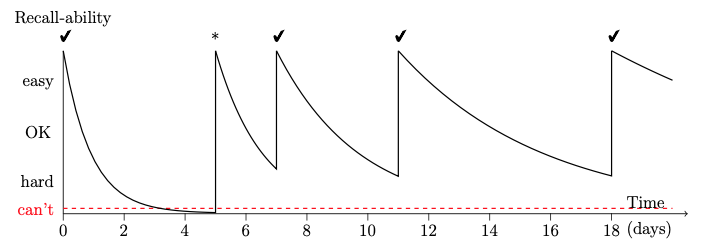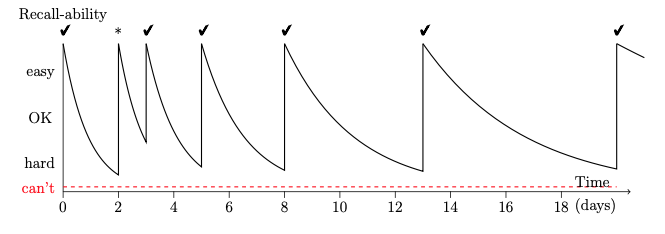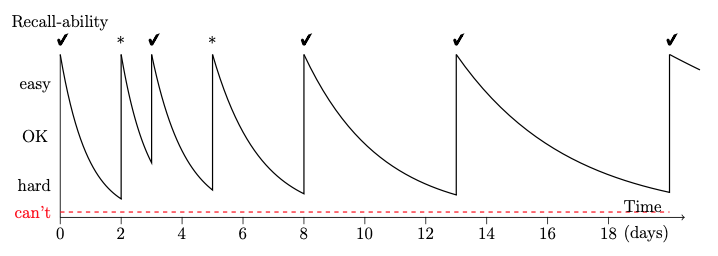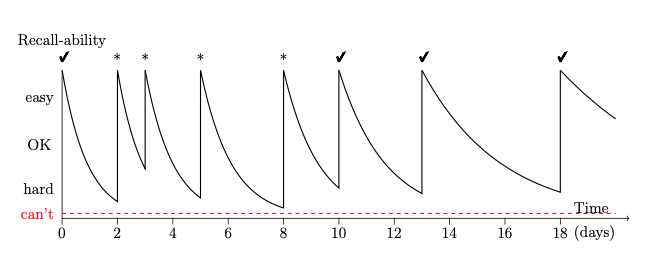This teacher training course is made of 5 topics, this topic: retrieval practice theory, is made of 3 layers and is suitable for both teachers and managers within a school.
The teacher may read about each layer here and if desired or required can use the timely practice app to embed the course into their long-term memory.
Quick summary
Increasing interval retrieval practice requires:
that we spread out practice over time - with an ever increasing wait between one practice and the next - rather than concentrate it in a block,
that we don’t precede practice questions with teaching to the question - so the learner must retrieve their learning from long term memory.
Most schools use a scheme of learning which requires teachers to teach each topic within a few days. During those few days the learners practise questions on what they have just learned, but do no more practice until they encounter the topic again in an end-of-unit or end-of-year test. This would be defined as blocked learning.
timely practice was devised to enable retrieval practice to be used by teachers. With timely practice some practice questions are done by learners directly after teaching, and some are spread out over the following lessons (the retrieval practice). The timely practice app gives each learner close to optimal spacing but typically spacing might be do another question 1 day after teaching, another question 2 days after that, then after 3 more, 5 more, 8 more etc. days.
The spacing tries to ensure that
learners practise learning before they would otherwise forget it - to avoid reminding, revising and reteaching
learners, by recall or attempted recall from long term memory, increase recall-ability
Soon what they have been taught becomes deeply embedded in their memory, yet remains readily accessible.
We say the learner has mastered that learning. Once mastered that learning becomes firm foundations for future learning.
(1) Ebbinghaus' forgetting curve
We have a cultural misunderstanding of learning within schooling - that learning is either secure or not.
However what we assess as secure within a few days/weeks/months of teaching may very well not be secure after a year or more.
As people we know that e.g. some of what we learned in our degree or the names of everyone in our class when we were in year 7, will be forgotten or partially forgotten without use, but as teachers and schools we prefer not to think of teaching and learning as so ephemeral. As with most progress, we must acknowledge and attempt to quantify the problem, before we can begin to solve the problem: I teach, you learn, they forget.
Ebbinghaus did a lot of work on learning and forgetting
If we learn something and don’t use it, we will forget it.
We - over a century later - often think of this in graph form.
Learners retain the learning of a lesson, for very different durations.
In the graph below we see the curves of learners who will forget
Not all low attaining learners forget within a week - but many do, not all high attaining learners retain new-learning for over a month - but many do. Improving learners' recall of learning will help many learners to improve their attainment. How we do this will vary.
Looking at the forgetting curves in the graph above - we suggest that learners who forget:
within 2 days, within 3 days and within a week are ideal for timely practice - we call these learners “our cohort”, as they most benefit from timely practice,
between 1 and 4 weeks although these learners will benefit from timely practice, they may gain almost as much from whole class retrieval practice,
over 4 weeks - these are typically high attaining learners, who homework and end-of-unit tests etc works well for - although it has to be said that most “top sets” in year 7 and 8 will contain a few learners who will benefit from timely practice and without a retrieval practice program may well be in middle or even lower middle sets by year 10 and 11.
(2) after success - increase the interval between one practice and the next
After a question is assessed with a tick within the app
the app updates the depth of learning - the duration which the app knows the learner can independently recall and accurately apply the learning of the lesson for
the app calculates the earliest date the layer should be asked again - to stretch the duration of the learner’s recall-ability of the learning of the layer
the app calculates the latest date the layer should be asked again - to ensure the learning is not forgotten
Each question is from the layer, and we assume that success on any question indicates some level of mastery on all similar questions within the layer.
With successful retrieval practice we are improving the recall of the faster forgetter (e.g forgets within 2 days), with a few retrieval practice questions (e.g. 5 retrieval practice questions) until they can remember as the best rememberers do (e.g. for over 4 weeks)
Over time, the fastest forgetter with retrieval practice can remember for longer than the best rememberer without retrieval practice. After a few more retrieval practice questions the interval (the wait between one practice and the next) will become several years. Often layers no longer need to be practised, because harder layers cover the same learning.
(3) after failure - give feedback and decrease the interval between one practice and the next
After a learner has attempted a retrieval practice question and doesn’t get it completely correct
sometimes the layer proves to be best learned later so feedback is not required,
sometimes the layer was asked very late (e.g. after a long weekend or holiday), so whole class/small group re-teaching might be more appropriate than feedback,
usually giving feedback and reducing the interval between one practice and the next is the best way to embed learning.
The app doesn’t need to know the reason why the learner couldn’t independently and accurately answer the question - but the teacher may like to bear in mind possible reasons - see chunk-based theory - as they give feedback.
Here are some graphs, to show how the timely practice app adjusts the interval between practices as a response to
correct - shown by a ✔︎ and
feedback - shown by a * assessment outcomes:
Feedback only required because of poorly spaced lessons or learner absence | Minimal feedback requirement |
Common feedback requirement | The teacher is very persistent with feedback - on this occasion it pays off. |
More about questions that need feedback after they are asked very late
Since most secondary classes don’t have maths lessons 7 days a week, the app can only do its best. When a layer is asked very late, sometimes feedback is required, sometimes revising or reteaching is required. The pitfalls to avoid are:
giving whole class teaching on a layer, which is in all the learners assignment, and then assessing the question in the assignment as if the learner has not had help. To avoid this, get the class to complete their assignment + then collect the assignments in + then do whole class/small group revising or reteaching.
reteaching or revising before learners have had a chance to retrieve - after all some learners may be able to retrieve. If we let learners try first, we have either stretched the recall-ability of that learning if they can retrieve or we have primed the learners for learning if they can not.
Sometimes we may be able to predict that most learners won’t be able to recall learning e.g. from the last maths lesson before a half term holiday, to the first maths lesson after the holiday. The teacher may prefer to
do project based learning in the last maths lesson before the holiday (along with a retrieval practice assignment),
only add the learning (of the last maths lesson before the holiday) “as taught” after revising or reteaching on the first maths lesson after the holiday.
Rest assured, even the most low attaining learners e.g. year 8 students who can’t work out 43 + 10, manage to learn with imperfect lesson spacing.
However the lowest attaining learners can also benefit from extra short practice assignments within the week and/or for homework if family support is available, to help fill the gaps created by poorly spaced lessons.
Once we can see learning slipping away to forgetting - through retrieval practice - then we can begin to find ways to reduce this.



